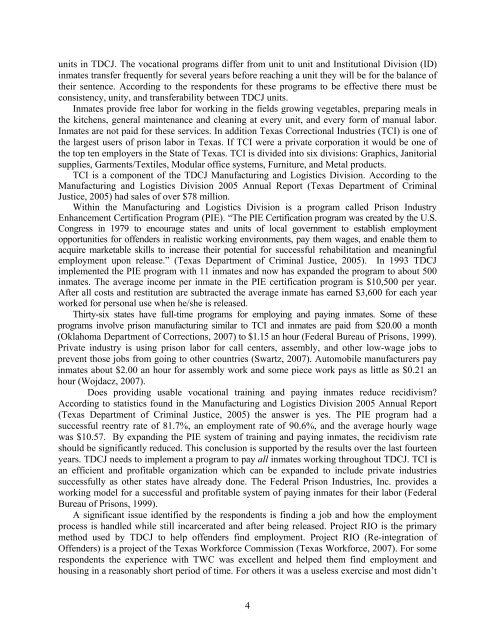The Secret Society: Descendants of Crypto-Jews in the San Antonio ...
The Secret Society: Descendants of Crypto-Jews in the San Antonio ...
The Secret Society: Descendants of Crypto-Jews in the San Antonio ...
You also want an ePaper? Increase the reach of your titles
YUMPU automatically turns print PDFs into web optimized ePapers that Google loves.
units <strong>in</strong> TDCJ. <strong>The</strong> vocational programs differ from unit to unit and Institutional Division (ID)<br />
<strong>in</strong>mates transfer frequently for several years before reach<strong>in</strong>g a unit <strong>the</strong>y will be for <strong>the</strong> balance <strong>of</strong><br />
<strong>the</strong>ir sentence. Accord<strong>in</strong>g to <strong>the</strong> respondents for <strong>the</strong>se programs to be effective <strong>the</strong>re must be<br />
consistency, unity, and transferability between TDCJ units.<br />
Inmates provide free labor for work<strong>in</strong>g <strong>in</strong> <strong>the</strong> fields grow<strong>in</strong>g vegetables, prepar<strong>in</strong>g meals <strong>in</strong><br />
<strong>the</strong> kitchens, general ma<strong>in</strong>tenance and clean<strong>in</strong>g at every unit, and every form <strong>of</strong> manual labor.<br />
Inmates are not paid for <strong>the</strong>se services. In addition Texas Correctional Industries (TCI) is one <strong>of</strong><br />
<strong>the</strong> largest users <strong>of</strong> prison labor <strong>in</strong> Texas. If TCI were a private corporation it would be one <strong>of</strong><br />
<strong>the</strong> top ten employers <strong>in</strong> <strong>the</strong> State <strong>of</strong> Texas. TCI is divided <strong>in</strong>to six divisions: Graphics, Janitorial<br />
supplies, Garments/Textiles, Modular <strong>of</strong>fice systems, Furniture, and Metal products.<br />
TCI is a component <strong>of</strong> <strong>the</strong> TDCJ Manufactur<strong>in</strong>g and Logistics Division. Accord<strong>in</strong>g to <strong>the</strong><br />
Manufactur<strong>in</strong>g and Logistics Division 2005 Annual Report (Texas Department <strong>of</strong> Crim<strong>in</strong>al<br />
Justice, 2005) had sales <strong>of</strong> over $78 million.<br />
With<strong>in</strong> <strong>the</strong> Manufactur<strong>in</strong>g and Logistics Division is a program called Prison Industry<br />
Enhancement Certification Program (PIE). “<strong>The</strong> PIE Certification program was created by <strong>the</strong> U.S.<br />
Congress <strong>in</strong> 1979 to encourage states and units <strong>of</strong> local government to establish employment<br />
opportunities for <strong>of</strong>fenders <strong>in</strong> realistic work<strong>in</strong>g environments, pay <strong>the</strong>m wages, and enable <strong>the</strong>m to<br />
acquire marketable skills to <strong>in</strong>crease <strong>the</strong>ir potential for successful rehabilitation and mean<strong>in</strong>gful<br />
employment upon release.” (Texas Department <strong>of</strong> Crim<strong>in</strong>al Justice, 2005). In 1993 TDCJ<br />
implemented <strong>the</strong> PIE program with 11 <strong>in</strong>mates and now has expanded <strong>the</strong> program to about 500<br />
<strong>in</strong>mates. <strong>The</strong> average <strong>in</strong>come per <strong>in</strong>mate <strong>in</strong> <strong>the</strong> PIE certification program is $10,500 per year.<br />
After all costs and restitution are subtracted <strong>the</strong> average <strong>in</strong>mate has earned $3,600 for each year<br />
worked for personal use when he/she is released.<br />
Thirty-six states have full-time programs for employ<strong>in</strong>g and pay<strong>in</strong>g <strong>in</strong>mates. Some <strong>of</strong> <strong>the</strong>se<br />
programs <strong>in</strong>volve prison manufactur<strong>in</strong>g similar to TCI and <strong>in</strong>mates are paid from $20.00 a month<br />
(Oklahoma Department <strong>of</strong> Corrections, 2007) to $1.15 an hour (Federal Bureau <strong>of</strong> Prisons, 1999).<br />
Private <strong>in</strong>dustry is us<strong>in</strong>g prison labor for call centers, assembly, and o<strong>the</strong>r low-wage jobs to<br />
prevent those jobs from go<strong>in</strong>g to o<strong>the</strong>r countries (Swartz, 2007). Automobile manufacturers pay<br />
<strong>in</strong>mates about $2.00 an hour for assembly work and some piece work pays as little as $0.21 an<br />
hour (Wojdacz, 2007).<br />
Does provid<strong>in</strong>g usable vocational tra<strong>in</strong><strong>in</strong>g and pay<strong>in</strong>g <strong>in</strong>mates reduce recidivism?<br />
Accord<strong>in</strong>g to statistics found <strong>in</strong> <strong>the</strong> Manufactur<strong>in</strong>g and Logistics Division 2005 Annual Report<br />
(Texas Department <strong>of</strong> Crim<strong>in</strong>al Justice, 2005) <strong>the</strong> answer is yes. <strong>The</strong> PIE program had a<br />
successful reentry rate <strong>of</strong> 81.7%, an employment rate <strong>of</strong> 90.6%, and <strong>the</strong> average hourly wage<br />
was $10.57. By expand<strong>in</strong>g <strong>the</strong> PIE system <strong>of</strong> tra<strong>in</strong><strong>in</strong>g and pay<strong>in</strong>g <strong>in</strong>mates, <strong>the</strong> recidivism rate<br />
should be significantly reduced. This conclusion is supported by <strong>the</strong> results over <strong>the</strong> last fourteen<br />
years. TDCJ needs to implement a program to pay all <strong>in</strong>mates work<strong>in</strong>g throughout TDCJ. TCI is<br />
an efficient and pr<strong>of</strong>itable organization which can be expanded to <strong>in</strong>clude private <strong>in</strong>dustries<br />
successfully as o<strong>the</strong>r states have already done. <strong>The</strong> Federal Prison Industries, Inc. provides a<br />
work<strong>in</strong>g model for a successful and pr<strong>of</strong>itable system <strong>of</strong> pay<strong>in</strong>g <strong>in</strong>mates for <strong>the</strong>ir labor (Federal<br />
Bureau <strong>of</strong> Prisons, 1999).<br />
A significant issue identified by <strong>the</strong> respondents is f<strong>in</strong>d<strong>in</strong>g a job and how <strong>the</strong> employment<br />
process is handled while still <strong>in</strong>carcerated and after be<strong>in</strong>g released. Project RIO is <strong>the</strong> primary<br />
method used by TDCJ to help <strong>of</strong>fenders f<strong>in</strong>d employment. Project RIO (Re-<strong>in</strong>tegration <strong>of</strong><br />
Offenders) is a project <strong>of</strong> <strong>the</strong> Texas Workforce Commission (Texas Workforce, 2007). For some<br />
respondents <strong>the</strong> experience with TWC was excellent and helped <strong>the</strong>m f<strong>in</strong>d employment and<br />
hous<strong>in</strong>g <strong>in</strong> a reasonably short period <strong>of</strong> time. For o<strong>the</strong>rs it was a useless exercise and most didn’t<br />
4
















